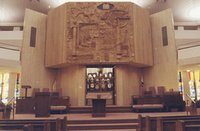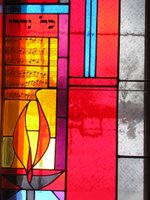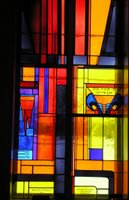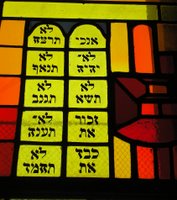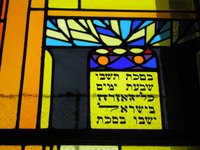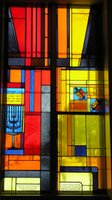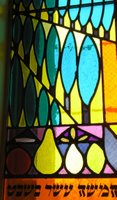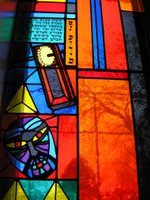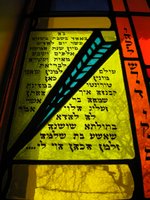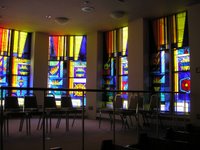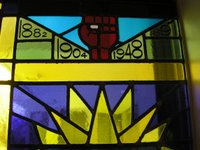About the building:
Beth Emeth Bais Yehuda is a Conservative congregation, located at 100 Elder Street in Downsview, Ontario. The building was constructed in April 1959 by the architectural firm of Freedman & Petroff.
Beth Emeth merged with the Bais Yehuda congregation in 1963, and the construction of a sanctuary, chapel, and additional classrooms began the following year.
The Sanctuary:
The stained glass windows are installed in the sanctuary, which is located on the North-East corner of the building. It is customary that the sanctuary faces East, and as such, the aron hakodesh (ark) is placed against the Eastern wall.
In Jewish tradition, art is regarded as a tool to enhance the spiritual experience. The Divine should be honoured in aesthetic surroundings, which are simple and do not distract from one's religious practice. The sanctuary at Beth Emeth Bais Yehuda is adorned with several beautiful art pieces that serve this purpose:
- "The Golden Gates": The ark doors were designed by Anita Aarons and fashioned from welded brass in a jewellery technique.
- The eternal light: A circle formed with the Hebrew word for
truth (Emeth), which is cast in gold-bronze, and
represents God's eternal presence. Also designed by Aarons.
- The ceramic mural/sculpture located above the ark: Designed by Merton Chambers, Aaron's husband and fellow artist, this 15X15 foot clay sculpture depicts the ten commandments, the holidays, and references to the Holocaust.
- Tapestry mural: Added by Aarons in 1969, the mural covers the ark doors and complements "The Golden Gates."
About the windows:
Materials & Techniques:
The windows are designed in the traditional stained glass technique. Hand-made blown glass is joined together by lead strips. Any text is written in brown-black vitreous paint, as are some of the images (Please see Zodiak window). The very brightly coloured glass is translucent, flooding the sanctuary with light while partially blocking out the outside world.
While some areas have sustained
damage over the years, the windows are in excellent condition. This is
likely due to the early addition of an exterior layer of clear glass,
which serves to protect the antique glass from the elements.
As Aarons was not a stained glass artist by training, she would have likely designed the windows and then had them manufactured by a stained glass studio. No information was found as to which studio created the windows.
Style:
The placement and
style of the windows reinforce the Eastern orientation of the
sanctuary. As the windows along the North wall approach the bimah,
they become lighter in colour, drawing the congregation's gaze forward.
The top third of each panel contains wedges that open up towards the
ceiling, elevating one's eyes upwards.
The composition of the
North windows is fairly uniform. A large area of coloured glass is
interspersed with lead lines to create a simple, geometric design. The
effect is reminiscent of Mondrian's grids and corresponds with the
rectilinear, abstracted aesthetic of 1950s design and architecture.
One area of each panel contains the representational imagery. The images are carefully chosen to represent the most important elements of the subject being depicted. These areas are kept close to eye level, reflecting the purpose of the windows as educational tools.
The East windows, which span both sides of the bimah,
are more densely packed than the North windows. Both sides of each
window contain the name of a key figure in Jewish history, a symbol
relating to his life and contributions, and a quote from his writings.
The exception to this program is the final window (located to the far
right of the bimah) which depicts a large peace
sign
overlapping a map of Israel on one side, and a red hand extending two
fingers in the peace sign on the other. The only writing in this window
are the words Shalom Israel; Peace in Israel.
Iconography:
The entire series of windows was installed simultaneously, during construction of the sanctuary. There are 24 windows in total: 13 on the North wall, and 11 on the East wall. The North windows deal with the theme of holidays and the Jewish life cycle. The East windows represent great biblical and Talmudic heroes, including important Zionist leaders.
As Beth Emeth Bais Yehuda is a Conservative synagogue, the images chosen to represent the holidays and figures are symbols rather than direct representations. This is in adherence with the Second Commandment, which states that:
“You shall not make for
yourself a sculptured image, or
any likeness of what is in the heavens above or on the earth below, or
in the
waters below the earth. You shall not bow down to them or serve
them…” (Exodus
20.4-5)
Rabbi Joseph Kelman, the founding Rabbi of BEBY, provided Aarons (who was not Jewish) with an overview of the Jewish holidays and historical personages, as well as relevant quotes for inclusion in the design.
The following is a list of the 13 North window, with an image and brief description. The order of the windows begins from the back of the sanctuary and continues until the front
1. Rosh Chodesh/Zodiak/Jewish Calendar:This window includes the Hebrew names and zodiak symbols of the 12 Jewish months. A blessing over the new moon (rosh chodesh) and a blessing over the first month (Nissan) are included.
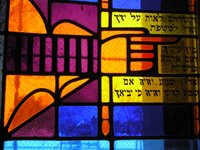 2. Bar
Mitzvah : This window includes an open hand ready to be
wrapped with tefillin (phylacteries);
a hand pointing at an open Torah scroll, as is customary when reciting
from the Torah; and the words to the biblical imperative to don the tefillin.
2. Bar
Mitzvah : This window includes an open hand ready to be
wrapped with tefillin (phylacteries);
a hand pointing at an open Torah scroll, as is customary when reciting
from the Torah; and the words to the biblical imperative to don the tefillin.
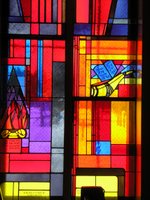 3. Rosh
Hashanah/Jewish New Year:
3. Rosh
Hashanah/Jewish New Year:
Images of the shofar,
ram's horns, and mountain with fire symbolize the story of the binding
of Isaac. The Torah portion included in the window is the one read on
the second day of the holiday.
4. Yom Kippur/Day of Atonement:
The day of judgment is represented by scales, a flame, and the transcribed music of the Kol Nidre prayer. The prayer is recited before sunset on the eve of Yom Kippur.
5. Pesach/Passover:
The
images of the parting of the sea and the door marked with blood
symbolize this holiday. The Jews in Egypt were instructed to spread the
blood of a sacrificial lamb on their door posts as a sign of their
devotion to God. Those whose doors were marked were spared (passed
over) from destruction.
6. Shavuot/harvest holiday:
This
window features an open scroll with a quote from the Book of Ruth,
which is recited on Shavuot. Ruth, a convert to Judaism, declares her
willing acceptance of the Bible. Shavuot is also the holiday of the
first fruits, which are depicted here as grapes and pears.
As
honouring the Holy Sabbath is the fourth commandment, the pillars with
the commandments are shown here. A candelabra and wineglass (kiddush
cup), used to fulfill the mitzvot of the day are
also represented.
This window features a sukkah (hut)
and the four species of fruit and grains which had agricultural
significance in the Temple rituals. The quote in this panel reflects
sukkoth as a time of great festivity after the high holy days.
A menorah and two dreidels were chosen to represent the important features of this holiday, which celebrates the triumph of the Jews over the Syrian Greek invaders.
10. Tu B'Shvat:
The new year of the trees is represented by rows of trees and fruit and a sapling being planted. The quotes compare men who follow the Torah to trees: their wisdom will grow and everything they do will succeed.
To show the carnival-like atmosphere of Purim, where the story of Mordechai and Esther triumphing over Haman is recited, a mask, grogger, and open megillah are included.
This window shows the huppah (canopy) which represents the home the future couple will share and the ketubah (contract). The ketubah contains the first lines of the contract from the member of the congregation who donated money for this window.
13. Emeth window:
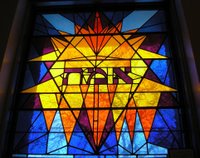 This window, located
above the door at the side of the sanctuary, is
unlike the others in shape or content. It is a purely decorative
element, incorporating the name of the synagogue and acts as a break
between the North and East series of windows.
This window, located
above the door at the side of the sanctuary, is
unlike the others in shape or content. It is a purely decorative
element, incorporating the name of the synagogue and acts as a break
between the North and East series of windows.
The East windows:
The East windows encompass the entire wall, beginning at the left of the bimah and continuing on the right. They will be listed with the name of the biblical or historical figure, and an image will be provided for some of the windows. Each window contains two names (Left/Right).
1. Abraham/Isaac
2. Jacob/Joseph
3. Moses/Moses
4. Aaron/David
5.
Beth Emeth/Bais Yehuda: As the creation of the windows was made
possible by the merger of the two congregations, this window symbolizes
their union. However, it is interesting to note that the two halves are
nonetheless divided by the bimah. These are also the only windows where
the writing faces out, towards the street.
6. Josiah/Ezra
7. Hillel/Rabban Yochanan ben Zachai
8. Akiva/Maimonides (Rambam)
9. Rashi/Ba'al Shem Tov
10. Eliyahu Gaon/Herzl
The
Herzl window lists important dates in the Zionist leader's life,
culminating in the creation of the State of Israel. The red fist may be
a symbol of Herzl's determination and drive to realize his dream.
11. Israel/Shalom
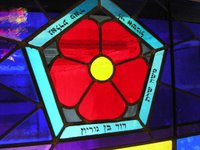
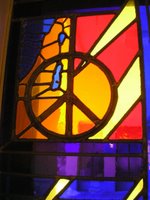 This
detail of the Shalom Israel window (right) features the names of
Israel's first Prime Ministers surrounding the red flower. An
interesting note is that while the windows were fully installed by
1967, Golda Meir's name is present. She was the PM from 1969-1974, so
her name must have been added at a later date; perhaps when Aarons came
in to install the tapestry for the Ark in 1969.
This
detail of the Shalom Israel window (right) features the names of
Israel's first Prime Ministers surrounding the red flower. An
interesting note is that while the windows were fully installed by
1967, Golda Meir's name is present. She was the PM from 1969-1974, so
her name must have been added at a later date; perhaps when Aarons came
in to install the tapestry for the Ark in 1969.
About the artist:
Anita Aarons (1912-2000) was born in Sydney, Australia, where
she
studied and attained professional status. Her work included sculpture,
jewellery, textile and print. In addition to being a practicing artist
and craftsperson, Aarons spent many years teaching sculpture,
lecturing, and consulting to Melbourne's Department of Education. She
was a founding member of the Contemporary Art Society and the Society
of Sculptors and Associates, which acted as liaison between sculptors,
designers, and architects. Aarons represented Australia at the First
World Congress of Crafts held in New York in 1964, after which she
toured the United States and Canada.
In 1964 Aarons moved
to Toronto, where she continued teaching sculpture and design at
Central Technical School. From 1965 to 1971, she served as Allied Arts
editor for Canadian Architecture. While in this
position, she
established a liaison office for artists and architects and published
two catalogues of current information on artists for architects.
Aarons played a defining role in the Canadian professional craft movement. She used her position as Allied Arts editor to harshly criticize what she perceived to be the poor standards of Canadian craft. Advocating for increased standards and professional education, Aarons sought to encourage architects to work with craftspeople on large scale commissions.
At the age of 64, Aarons founded and directed
the Harbourfront Art Gallery. Her goals for the gallery were to create
a dialogue between emerging artists and the established art industry
and to educate the public about contemporary art.
In 1983, Anita
Aarons was awarded the Diplome d'Honneur by the Canadian Conference of
the Arts. She returned to Australia two years later, where she lived
until her passing in 2000. She was awarded the Order of Australia medal
in 1994 for her lifelong commitment to the arts.
Sources:
Aarons,
Anita. "Art and Architecture". Journal
R.A.I.C ., 42(1), (January 1965): 55-56.
Alfoldy, Sandra. Crafting
Identity: The Development
of Professional Fine Craft in
Kaniel, Michael. A Guide to
Jewish Art.
Kelman, Rabbi Joseph. Interview by Or Har-Gil. Beth Emeth Bais Yehuda, 25 February 2008.
Kelman, Rabbi Joseph. The Eastern Wall of the Beth Emeth Bais Yehuda Synagogue. Toronto.
Muir, Barbara. “
Veale, Sharon. "Anita Aarons." Dictionary of
Australian Artists Online (2007),
http://www.daao.org.au/main/read/3.
